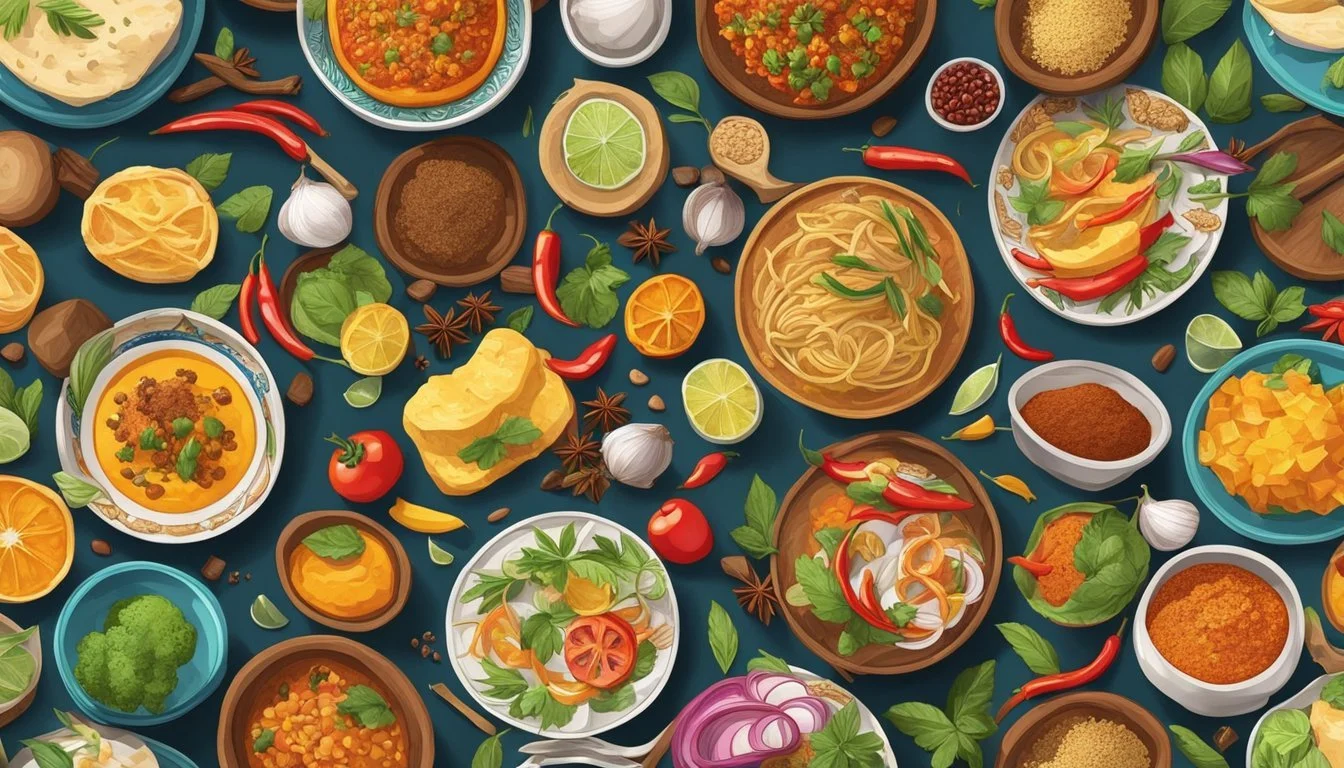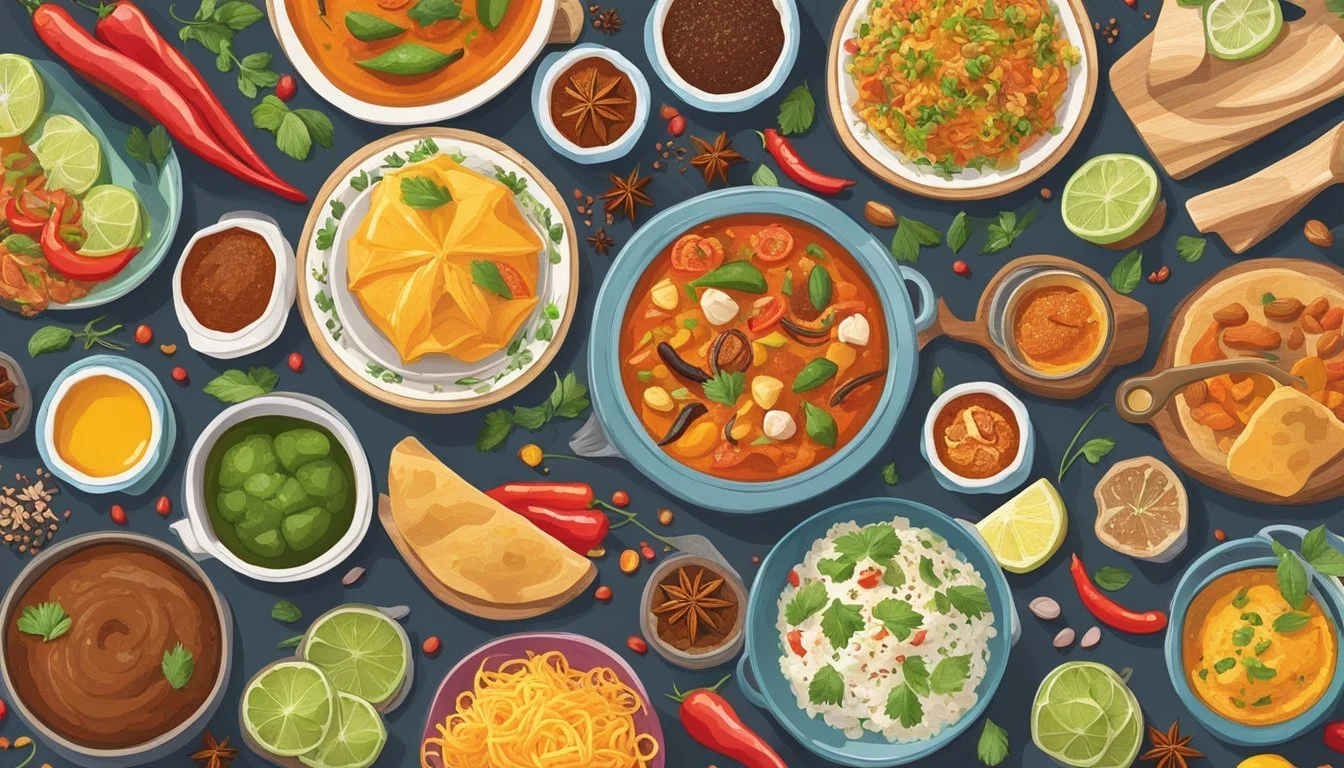Swicy Around the World
Explore Global Cuisine with a Sweet-Spicy Flavor Fusion
The culinary landscape is continuously evolving, and one flavor fusion taking the global food scene by storm is the combination of sweet and spicy, widely known as 'swicy.' This trend highlights a harmonious blend of sweetness that offsets the heat of spices, creating a sensory experience that is both balanced and bold. Swicy dishes are gaining popularity as they cater to a palate seeking complexity and depth in flavor profiles. They are not confined to one specific cuisine but are found across various cultures, each bringing a unique twist to this taste sensation.
International kitchens have long celebrated the union of sweet and spicy elements. In recent years, this preference has seen a surge in mainstream gastronomy, with restaurants incorporating swicy flavors into their signature offerings. The appeal of swicy lies in its versatility, as it can enhance a wide array of dishes, from savory meals to beverages and desserts. This culinary trend taps into the natural human desire for diversity in taste, providing an adventurous eating experience that can be both comforting and exhilarating.
Ingredients like hot honey, chili-infused chocolates, and sweet-spicy sauces are some of the key players driving the swicy movement. Their growing presence on menus is a testament to the trend's adaptability and widespread appeal. By exploring swicy flavors, chefs are able to push the boundaries of traditional recipes and offer diners an innovative twist on classic dishes from around the world. The swicy trend stands as a vibrant example of how flavor experimentation can lead to new and exciting dining experiences.
Exploring Swicy: The Fusion of Sweet and Spicy
In global cuisine, "swicy" has emerged as a trend where the line between sugary delights and peppery heat is deliciously blurred, demonstrating the innovative blend of flavors that can redefine a dining experience.
The Rise of Swicy in Global Cuisine
The term "swicy" underscores a burgeoning culinary phenomenon where sweet meets spicy, creating a harmonious marriage of flavors. Global cuisine has seen a significant uptick in the appearance of swicy dishes on menus, with a reported increase in offerings that pair the heat of capcaisin—the compound found in chili peppers that imparts spiciness—with the soothing qualities of sugar. These offerings range from condiments, like hot sauce, to full-fledged entrées.
International Dishes with Swicy Flavors:
Sauces: Hot honey, chili-infused chocolate, spicy maple syrup
Asian Cuisine: Korean gochujang glazed dishes, Thai sweet chili stir-fries
American Fusion: Spicy barbecue accompanied by sweet cornbread
Latin American: Mango with chili powder, sweet-spicy salsas
Understanding the Swicy Flavor Profile
When one indulges in a swicy dish, it activates a complex dance on the palate. The fusion of sugar's sweetness with spice's zing fundamentally brings balance to a dish, where the sweetness can temper excessive heat, allowing more nuanced flavors to emerge. Moreover, spicy food is known to trigger endorphin release, enhancing the dining experience beyond mere taste and contributing to the popularity of the swicy trend.
Key Components of Swicy Flavor:
Sweet Elements: Often derived from fruits, honey, or other natural sugars
Spicy Components: Typically involve capsaicin-containing elements such as chili peppers
Fusion: Achieved by careful blending, often highlighting one flavor before the other ensues
Through the strategic interplay of sweet and spicy, swicy foods offer a distinctive taste that caters to an adventurous palate seeking to explore a more dynamic spectrum of flavors.
Key Ingredients for the Perfect Swicy Dish
A perfect swicy dish requires a delicate balance of flavors. It often involves a blend of spices and condiments to achieve the fiery kick, complemented by sweet undertones to create a harmonious taste experience.
Essential Spices and Condiments
Capsaicin: The active component in chili peppers that gives dishes their heat.
Common sources include jalapeños, habaneros, and cayenne peppers.
Gochujang: A Korean fermented condiment that brings heat with a hint of sweetness.
Made from red chili, glutinous rice, fermented soybeans, and salt.
Garlic and Ginger: Aromatics that add depth and heat to swicy dishes.
They can be used fresh, powdered, or as pastes.
Tajín: A tangy and spicy Mexican seasoning made with chili peppers, lime, and salt.
Often sprinkled on fruits and vegetables for a swicy twist.
Swicy Sauce Staples
Hot Sauce: A versatile ingredient that can be adjusted for the level of spiciness.
Can range from mildly hot to extremely spicy.
Hot Honey: Honey infused with chili peppers, adding both sweetness and heat.
Drizzled over dishes to enhance flavor profiles.
Sweet Elements in Swicy Cuisine
Brown Sugar: Adds molasses-like sweetness, which caramelizes well with spicy components.
Often used in marinades and glazes to balance the heat.
Vegetables: Some like carrots and bell peppers bring natural sweetness to a swicy dish.
Also contribute to the dish's textural variety.
Umami Rich Ingredients: Such as soy sauce or mushrooms, they provide a savory backdrop that can enhance the perception of both sweet and spicy notes.
Swicy Around the World
The concept of swicy—where sweet meets spicy—transcends borders and has been embraced internationally, creating unique flavor profiles in various cuisines.
Swicy in Asian Cuisine
In South Korea, the dish tteokbokki embodies the swicy trend, featuring rice cakes in a sauce that's both sweet and fiery. Meanwhile, bibimbap can also take on a swicy character when mixed with a sweet-spicy gochujang sauce. Chinese cuisine contributes with dishes like Kung Pao Chicken, where the heat of Sichuan peppercorns is mellowed by a touch of sugar.
Japan has taken to swicy flavors through condiments like sweet chili sauce, often drizzled over sushi rolls to add a spicy zing. Thai cuisine has long mastered this balance, with dishes such as sweet chili chicken making swicy a palatable staple.
Swicy in Latin American Cuisine
Mexican cooking incorporates swicy flavors notably in its assortment of salsas and tacos, where the sweetness of tropical fruits blends with the heat of habanero or chipotle peppers. Fusion dishes take this concept even further, marrying traditional recipes with swicy touches, like a mango-habanero salsa over grilled fish.
Swicy in North American Cuisine
In the United States, the swicy trend manifests in diverse applications, from gourmet pizza topped with hot honey and pepperoni to innovative fast food options that include sweet-spicy sauces. Swicy flavors have also infiltrated the condiment market, with hot honey being a notable addition to everything from fried chicken to roasted vegetables. (What wine goes well with roasted vegetables?)
Swicy in Popular Culture and Dining
Swicy, the fusion of sweet and spicy flavors, has become a significant trend in the food industry, influenced by changing consumer preferences and culinary innovation. This trend has permeated popular culture and dining, with an evident impact on fast food offerings, gourmet cuisine, and the social media landscape.
Fast Food Innovations
Fast food chains have quickly adapted to the swicy trend, introducing items that cater to the evolving tastes of millennials and Gen Z. For instance, Pizza Hut capitalized on the trend by incorporating hot honey on their pizzas, an ingredient that saw a significant uptick according to market research firm Datassential. Chick-fil-A also added a twist to their menu with the introduction of a sweet and spicy sriracha sauce, catering to those who seek a swicy kick to the traditional flavors.
Gourmet Swicy Creations
At the gourmet level, chefs like Andrea Ramirez have crafted dishes that elevate the swicy profile to new culinary heights. Upscale dining establishments such as Outback Steakhouse have integrated swicy elements into their dishes, understanding that the interplay between sweet and spicy can offer a complex and satisfying taste experience.
Examples:
Glazed Pork Chops: (What wine goes well with pork chops?) Coated with a sweet chili and honey glaze.
Swicy Mango Salad: Combining ripe mangoes with a hint of chili.
Swicy on Social Media and Millennials
Social media platforms, particularly with the influence of millennials, have propelled the popularity of swicy flavors. The visual appeal of swicy dishes garners attention on platforms like TikTok and Instagram, where food trends can go viral overnight. Torani, known for their flavoring syrups, has seen an increase in their sweet heat products, suggesting a growing demand for swicy options in beverages as well. As influencers share their favorite swicy concoctions, the trend continues to spread, with new swicy-inspired hashtags emerging regularly.
Social Media Highlights:
Hashtags: #Swicy, #SweetSpicyChallenge, #HotHoney
Popular Creations: Swicy chicken wings, hot honey margaritas
The Swicy Dining Experience
The "Swicy Dining Experience" encapsulates a culinary trend where diners indulge in dishes that harmonize the heat of spices with the mellowness of sweetness. These dishes have the potential to offer an amplified flavor profile that can be enhanced with the right beverage pairings and serving suggestions.
Pairing Swicy Dishes with Beverages
When it comes to enhancing swicy dishes, beverage pairings play a pivotal role. A well-chosen drink can complement the flavor nuances and add to the overall dining experience.
Cocktails: Cocktails that include a sweet component, such as those with a fruit base, or a spicy edge, like those with a hint of chili, can be particularly effective. They should not overpower the dish but rather act as a palate cleanser or a flavor enhancer.
Wine: A semi-sweet Riesling or a chilled rosé can provide a refreshing counterbalance to the spiciness in swicy dishes, while the wine's natural sweetness can harmonize with the sweet elements of the food.
Beer: Wheat beers or fruity ales bring out the complexity of swicy flavors. Their effervescence can offer a refreshing contrast to the richness of the dish.
Serving Suggestions for Swicy Entrees
For the optimal swicy dining experience, presentation and accompaniments are key. They set the stage for the swicy flavors to shine and can add textural contrast to the dish.
Cheese Board: A cheese board with milder cheeses can act as a neutral base against swicy entrees. Cheeses such as brie or goat cheese won't compete with the main dish's assertive flavors.
Charcuterie: The incorporation of cured meats can offer a savory counterpart that complements the sweet-spicy profile of the swicy dish.
Cheese Boards: Expanded cheese boards including fruits like sliced apples or grapes can provide a sweet relief between bites of a swicy dish.
By carefully selecting beverages and considering thoughtful serving suggestions, one can elevate the swicy dining experience to create a memorable meal that tastefully marries the sweet with the spicy.
Creating Your Own Swicy Dishes
Embracing the swicy trend involves blending sweet and spicy flavors to create dishes that cater to a variety of palates. Here’s how home cooks and professional chefs alike can master this flavorful fusion at home.
Home Cooking with Swicy
Incorporating swicy elements into home cooking starts with recognizing the importance of balance. A simple formula is to pair sweet ingredients like honey or fruit jams with spicy components such as chili flakes or hot sauce. Home cooks may experiment with these combinations in sauces, marinades, or glazes that can complement a range of dishes. For example, a sweet mango chutney can be upgraded with a hint of cayenne pepper to drizzle over grilled chicken.
Basic Swicy Sauce Recipe:
1/4 cup honey
2 tablespoons hot sauce
1 tablespoon soy sauce
1 clove of garlic, minced
Pinch of ground ginger
Cooking Technique: Heat all ingredients in a small saucepan over medium heat, stirring until combined. Simmer for a few minutes to allow flavors to meld.
Swicy dishes often require minimal additional seasonings, as the complexity of the swicy pairings brings out robust flavors. They can also opt for easy-to-make side dishes that support the main swicy components, like a bowl of plain white rice or simple roasted vegetables, which allow the swicy flavors to shine.
Tips from Expert Chefs
Expert chefs suggest that the key to perfecting swicy dishes is precise seasoning and paying attention to the quality of ingredients. High-quality spices and fresh, ripe fruits will produce a better flavor profile for the dish. Chefs recommend tasting as you go to ensure the optimal balance between sweet and spicy.
Chef's Advice for Swicy Perfection:
Start with less heat; you can always add more.
Use natural sweeteners like agave or maple syrup for a complex taste.
Consider the color contrast as swicy dishes are as much about visual appeal as taste.
Cooking techniques like caramelizing sugars or toasting spices can deepen the flavors in swicy dishes. Chefs note that the cooking method, whether it's grilling, baking, or sautéing, can influence how the flavors interact and develop. They encourage home cooks to not shy away from experimenting with different techniques to find the perfect swicy creation.
Swicy: Trends and Future Directions
The integration of sweet and spicy elements, known as 'swicy,' is redefining flavor profiles on global menus. This section explores its current impact on the food industry and anticipates how it will shape future culinary experiences.
The Role of Swicy in Modern Food Trends
'Swicy' has emerged as the new culinary darling, with its grasp on modern food trends becoming increasingly apparent. This combination not only pleases the palate but also elevates dining to a multisensory experience. Food industry reports indicate a 38% increase in swicy pairings on menus, showcasing the demand for this harmonious meld of flavors.
Haute Cuisine: Swicy components are progressively being incorporated into high-end dining as chefs seek to innovate and provide unique taste experiences.
Consumer Appeal: The endorphin release associated with spicy foods, coupled with the smoothing effect of sweet flavors, caters to a broad audience, enhancing dishes' appeal.
Predictions for Swicy's Evolution in Cuisine
The trajectory of swicy flavors is leaning towards a standard in culinary evolution. Its versatility allows for broad application, from casual dining to gourmet creations, hinting at a stable future within the food industry.
Innovation: Expect swicy elements to transform into a fundamental aspect of dish creation, with chefs experimenting beyond traditional boundaries.
Future Trends: The incorporation of swicy flavors provides a fertile ground for the emergence of new combinations that may redefine contemporary palates.
In conclusion, the swicy trend is well-positioned for growing integration into global cuisines, promising exciting developments in the realms of flavor innovation and culinary arts.
Appendix: Swicy Recipe Collection
The world of swicy recipes is as diverse as it is flavorful. Below is a curated collection of international dishes that embody the perfect balance of sweet and spicy notes.
Ema Datshi: A fiery Bhutanese stew, Ema Datshi brings the heat with chili peppers, complemented by the creamy texture and unique taste of yak cheese.
Hot and Sour Soup: In China, Hot and Sour Soup marries the peppery spice of chili with the tang of rice vinegar, enriched by mushrooms, bamboo shoots, and tofu.
For a quick reference, the following table captures the essence of several swicy recipes from around the globe:
Country Dish Key Sweet Ingredients Key Spicy Ingredients Bhutan Ema Datshi Yak cheese Chili peppers China Hot and Sour Soup Soy sauce, Rice vinegar Chili pepper sauce Global Trend Swicy Condiments Sugar Chili flakes, Hot sauce
These recipes showcase the seamless blend of sugar and spice to create a symphony of flavors that tease the palate. The culinary sensation of swicy is not confined to savory dishes, but extends into the realm of confectionary and chocolate, where the impeccable duo of sweetness paired with a touch of heat results in an entirely new taste profile.
It's important to note that the intensity of sweetness and heat can be adjusted according to one's preference, allowing the adventurous to experiment within the framework of swicy to find their perfect match.
Acknowledgments
This article has been informed by various culinary experts, food enthusiasts, and cultural commentators who have explored and shared the complexities of the swicy (sweet and spicy) food trend.
The team thanks the contributors from Paste Magazine, who highlighted the intricate balance between spicy and sweet sensations that the swicy trend encapsulates. The palette's response to this dichotomy provides a heightened gustatory experience, shedding light on the underlying neurological processes involved.
Gratitude is also extended to researchers who have articulated the scientific nuances behind the spiciness sensation, emphasizing that it is not a taste but a physical reaction, engaging different parts of the brain.
Moreover, the article has been enriched by the international scope provided from various sources. They illuminate dishes such as a hearty soup blending sweet potatoes and peanut butter for a comforting and complex profile. Their contribution underscores the depth and versatility of swicy combinations in global cuisines.
Cook Eat World is recognized for their insights into Afghani cuisine, which combines sweet, seasonal fruits with warm, aromatic spices, reflecting the harmonious swicy essence within its traditional dishes.
Lastly, appreciation is conveyed to food writers who celebrate creativity in cooking, advocating for the adventurous fusion of ingredients that propel international dishes into new, vibrant territories.
The collective wisdom of these sources has been pivotal in articulating the universal appeal of swicy flavors and their resonance in contemporary dining trends worldwide.









